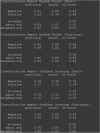Machine learning approaches to detect hepatocyte chromatin alterations from iron oxide nanoparticle exposure
- PMID: 39179629
- PMCID: PMC11344034
- DOI: 10.1038/s41598-024-70559-4
Machine learning approaches to detect hepatocyte chromatin alterations from iron oxide nanoparticle exposure
Abstract
This study focuses on developing machine learning models to detect subtle alterations in hepatocyte chromatin organization due to Iron (II, III) oxide nanoparticle exposure, hypothesizing that exposure will significantly alter chromatin texture. A total of 2000 hepatocyte nuclear regions of interest (ROIs) from mouse liver tissue were analyzed, and for each ROI, 5 different parameters were calculated: Long Run Emphasis, Short Run Emphasis, Run Length Nonuniformity, and 2 wavelet coefficient energies obtained after the discrete wavelet transform. These parameters served as input for supervised machine learning models, specifically random forest and gradient boosting classifiers. The models demonstrated relatively robust performance in distinguishing hepatocyte chromatin structures belonging to the group exposed to IONPs from the controls. The study's findings suggest that iron oxide nanoparticles induce substantial changes in hepatocyte chromatin distribution and underscore the potential of AI techniques in advancing hepatocyte evaluation in physiological and pathological conditions.
Keywords: Gradient boosting; Machine learning; Nucleus; Random forest; Toxicology.
© 2024. The Author(s).
Conflict of interest statement
The authors declare no competing interests.
Figures






Similar articles
-
Effects of Iron Oxide Nanoparticles on Structural Organization of Hepatocyte Chromatin: Gray Level Co-occurrence Matrix Analysis.Microsc Microanal. 2021 Aug;27(4):889-896. doi: 10.1017/S1431927621000532. Microsc Microanal. 2021. PMID: 34039461
-
FTIR microspectroscopy revealed biochemical changes in liver and kidneys as a result of exposure to low dose of iron oxide nanoparticles.Spectrochim Acta A Mol Biomol Spectrosc. 2020 Aug 5;236:118355. doi: 10.1016/j.saa.2020.118355. Epub 2020 Apr 13. Spectrochim Acta A Mol Biomol Spectrosc. 2020. PMID: 32344375
-
Toxicity and biodistribution assessment of curcumin-coated iron oxide nanoparticles: Multidose administration.Life Sci. 2021 Jul 15;277:119625. doi: 10.1016/j.lfs.2021.119625. Epub 2021 May 17. Life Sci. 2021. PMID: 34015288
-
Iron oxide nanoparticles for biomedical applications: an updated patent review (2015-2021).Expert Opin Ther Pat. 2022 Sep;32(9):939-952. doi: 10.1080/13543776.2022.2109413. Epub 2022 Aug 9. Expert Opin Ther Pat. 2022. PMID: 35929879 Review.
-
Iron oxide nanoparticle targeting mechanism and its application in tumor magnetic resonance imaging and therapy.Nanomedicine (Lond). 2022 Sep;17(21):1567-1583. doi: 10.2217/nnm-2022-0246. Epub 2022 Dec 2. Nanomedicine (Lond). 2022. PMID: 36458585 Review.
Cited by
-
Radiomics of Dynamic Contrast-Enhanced MRI for Predicting Radiation-Induced Hepatic Toxicity After Intensity Modulated Radiotherapy for Hepatocellular Carcinoma: A Machine Learning Predictive Model Based on the SHAP Methodology.J Hepatocell Carcinoma. 2025 May 17;12:999-1015. doi: 10.2147/JHC.S523448. eCollection 2025. J Hepatocell Carcinoma. 2025. PMID: 40406666 Free PMC article.
References
MeSH terms
Substances
Grants and funding
LinkOut - more resources
Full Text Sources

